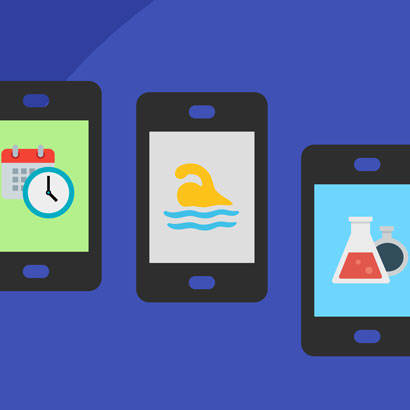
Research has shown that using mobile technology is a great way to improve efficiency and effectiveness in organizations. What can and cannot be done using technology is basically limited by the creativity of the individual. For the aquatics industry, there are several ways to effectively use mobile technology in order to boost productivity and efficiency, and following are seven ways to do so across an organization:
1. Summer return letters
This process can be automated by using a “forms for service” company. There are several web solutions that allow users to easily create custom fields to collect information and email staff members with a link to fill out forms online. Better yet, all form submissions can easily be viewed online or exported for further analysis and for administrative use. Another way to handle this is through the use of an online-to-print service. Many online-to-print services allow users to upload lists of employee information and mailing addresses and can handle sending the letters to the respective staff members.
2. Pool logs/chemical dosages
“Forms for service” providers can also be used to keep pool logs or chemical record logs. Users can set up forms with custom dropdowns for the various facilities they operate and for each body of water at those facilities. Once the data is submitted, the forms can be easily printed for the local health department. Another benefit to having digitized pool logs is the ability to analyze the data and identify trends over time. With regard to keeping track of chemical dosage calculations, there are a variety of apps on the market to help organizations streamline their chemical dosage recommendations. This is especially helpful for newer pool operators, but is also useful for any employee who deals with chemicals.
3. Staff scheduling
Scheduling involves a variety of processes, including creating the schedule, handling staff availabilities, coordinating vacation requests and notifying staff about the schedule. Once the schedule is posted, the issue becomes managing all the changes that can occur, such as employees trading shifts, and keeping the staff informed of those changes.
Generally, staff scheduling is done using pen and paper or spreadsheet software. The problem with these methods is that there is no easy way of posting the most up-to-date version of the schedule in real time. One solution is using an online scheduling tool. This tool has gained some traction in the aquatics industry, but it fails to provide good integration in the space for aquatics, which has specific challenges, such as multiple locations, employee sharing across facilities, and private/group swimming lessons. However, it is a much better solution than using spreadsheets or pen and paper.
4. Document storage
Most organizations have endless filing cabinets full of paperwork, and, for the most part, offer no way for staff to digitally access needed documents. Some organizations have set up local-network drives to handle this, but the drawback is that often security credentials are required to access them outside of the organization network, leaving employees with limited access to the data. Using an online cloud-based file storage solution is a great way of providing employees with access to files, inside or outside an organization’s network, and on any mobile device.
5. Staff communication
Most staff members use email and text messages to communicate with their supervisors and co-workers. Other common tools include social networks, mobile apps and group text messages. The disadvantage to these methods is the possible lack of a reliable way for supervisors to connect with staff to convey the most up-to date information for their employees, and the lack of conveying a structured organization-sponsored solution. Some staff scheduling tools have messaging systems built in, which is one of the better solutions to the communication challenges organizations face.
6. Preventative maintenance
Preventative maintenance is another area of concern that organizations can continually improve on. Many lifeguards must use a piece of paper or a whiteboard to check off each preventative maintenance task they are assigned. This is a tool that many organizations still use today. A simple to-do list app or a team-focused to-do list that’s web/mobile based is a great way to update this process. Best of all, employees and supervisors could get notifications when tasks are completed. This provides supervisors the ability to see if their staff is getting the needed tasks done on time.
7. Patron counts/usage
Numerous organizations have ways of tracking how many patrons are in the facility at a given time using the registration system at the front desk. But, what about once patrons are in the facility? How do you know if they are using the pool, the weight room or the basketball gym? Tracking pool usage across the various aquatics facility areas — lap swimming area, diving well, aqua fitness class — can be tedious, but the data is invaluable. Lifeguards may count the people in a given area and record that information in a log that goes in the filing cabinet for the supervisor. Then, perhaps, once a month the supervisor has to painstakingly sift through stacks of patron counts and enter them in a spreadsheet to get useful insights. This is not an uncommon problem. One solution is to set up an online form, and customize it with a drop-down menu for the facility and the specific area needed to be tracked. Once the data is collected and exported to a spreadsheet, it becomes very easy to calculate averages, minimums, maximums and more. From there, organizations can see where there is room to add more programs or optimize the number of staff members needed for a specific time/event.
I hope these suggestions will help you, your staff and your organization become more efficient and truly embrace the benefits of technology in aquatics.
Michael Pierce is Co-Founder and CTO at DigiQuatics.

